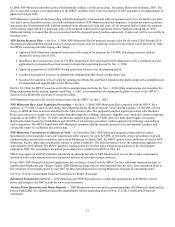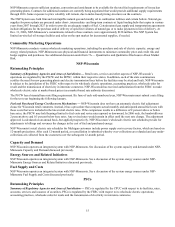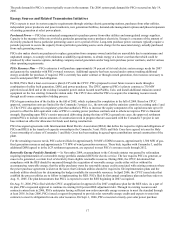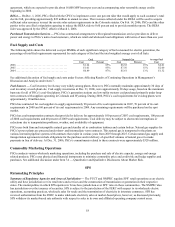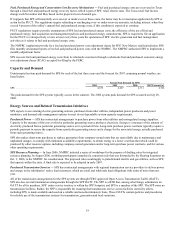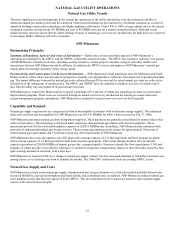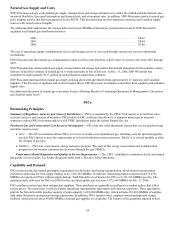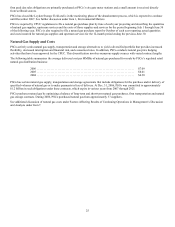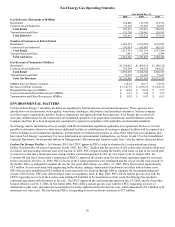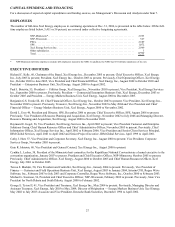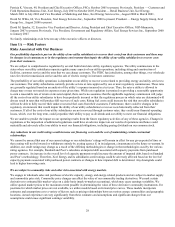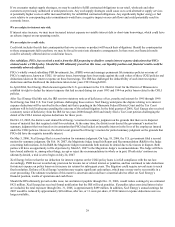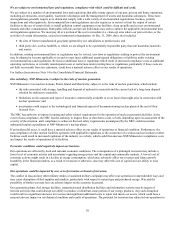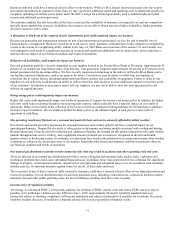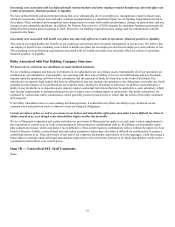Xcel Energy 2006 Annual Report Download - page 32
Download and view the complete annual report
Please find page 32 of the 2006 Xcel Energy annual report below. You can navigate through the pages in the report by either clicking on the pages listed below, or by using the keyword search tool below to find specific information within the annual report.22
NATURAL GAS UTILITY OPERATIONS
Natural Gas Utility Trends
The most significant recent developments in the natural gas operations of the utility subsidiaries were the continued volatility in
wholesale natural gas market prices and the continued trend toward declining use per customer by residential customers as a result of
improved building construction technologies and higher appliance efficiencies. From 1996 to 2006, average annual sales to the typical
residential customer declined from 103 MMBtu per year to 82 MMBtu per year on a weather-normalized basis. Although recent
wholesale price increases do not directly affect earnings because of natural gas cost recovery mechanisms, the high prices are expected
to encourage further efficiency efforts by customers.
NSP-Minnesota
Ratemaking Principles
Summary of Regulatory Agencies and Areas of Jurisdiction — Retail rates, services and other aspects of NSP-Minnesota’s
operations are regulated by the MPUC and the NDPSC within their respective states. The MPUC has regulatory authority over aspects
of NSP-Minnesota’s financial activities, including security issuances, certain property transfers, mergers with other utilities and
transactions between NSP-Minnesota and its affiliates. In addition, the MPUC reviews and approves NSP-Minnesota’s natural gas
supply plans for meeting customers’ future energy needs.
Purchased Gas and Conservation Cost Recovery Mechanisms — NSP-Minnesota’s retail natural gas rates for Minnesota and North
Dakota include a PGA clause that provides for prospective monthly rate adjustments to reflect the forecasted cost of purchased natural
gas. The annual difference between the natural gas costs collected through PGA rates and the actual natural gas costs are collected or
refunded over the subsequent 12-month period. The MPUC and NDPSC have the authority to disallow recovery of certain costs if
they find the utility was not prudent in its procurement activities.
NSP-Minnesota is required by Minnesota law to spend a minimum of 0.5 percent of Minnesota natural gas revenue on conservation
improvement programs. These costs are recovered through an annual cost recovery mechanism for natural gas conservation and
energy management program expenditures. NSP-Minnesota is required to request a new cost recovery level annually.
Capability and Demand
Natural gas supply requirements are categorized as firm or interruptible (customers with an alternate energy supply). The maximum
daily send-out (firm and interruptible) for NSP-Minnesota was 601,336 MMBtu for 2006, which occurred on Feb. 17, 2006.
NSP-Minnesota purchases natural gas from independent suppliers. These purchases are generally priced based on market indices that
reflect current prices. The natural gas is delivered under natural gas transportation agreements with interstate pipelines. These
agreements provide for firm deliverable pipeline capacity of 526,013 MMBtu/day. In addition, NSP-Minnesota has contracted with
providers of underground natural gas storage services. These storage agreements provide storage for approximately 30 percent of
winter natural gas requirements and 37 percent of peak day, firm requirements of NSP-Minnesota.
NSP-Minnesota also owns and operates one LNG plant with a storage capacity of 2.13 Bcf equivalent and three propane-air plants
with a storage capacity of 1.4 Bcf equivalent to help meet its peak requirements. These peak-shaving facilities have production
capacity equivalent to 250,300 MMBtu of natural gas per day, or approximately 34 percent of peak day firm requirements. LNG and
propane-air plants provide a cost-effective alternative to annual fixed pipeline transportation charges to meet the peaks caused by firm
space heating demand on extremely cold winter days.
NSP-Minnesota is required to file for a change in natural gas supply contract levels to meet peak demand, to redistribute demand costs
among classes, or to exchange one form of demand for another. The 2006-2007 entitlement levels are pending MPUC action.
Natural Gas Supply and Costs
NSP-Minnesota actively seeks natural gas supply, transportation and storage alternatives to yield a diversified portfolio that provides
increased flexibility, decreased interruption and financial risk, and economical rates. In addition, NSP-Minnesota conducts natural gas
price hedging activity that has been approved by the MPUC. This diversification involves numerous domestic and Canadian supply
sources with varied contract lengths.


